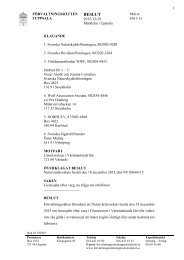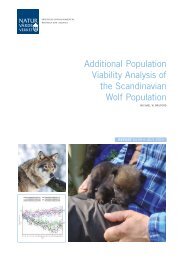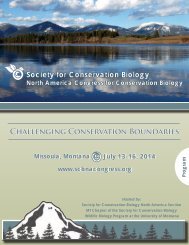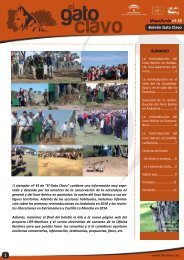1oC3Dbk
1oC3Dbk
1oC3Dbk
Create successful ePaper yourself
Turn your PDF publications into a flip-book with our unique Google optimized e-Paper software.
listing as the official status of the species. As such, this marks<br />
a significant advancement and an important breakthrough in<br />
the long-running debate about the utility of IUCN Red List<br />
criteria for widely distributed, long-lived species such as<br />
marine turtles. The subpopulation listing comes after the<br />
careful development by the MTSG of two key processes: The<br />
delineation of Regional Management Units for sea turtles<br />
(Wallace et al. 2010) which was recognized by IUCN as proxy<br />
for IUCN Red List subpopulations, and the subsequent<br />
prioritisation exercise to focus conservation where it is most<br />
urgently needed (Wallace et al. 2011). These new listings<br />
provide an invaluable tool for prioritizing sea turtle conservation<br />
at all scales, by more accurately reflecting the wide variation in<br />
the risk of extinction faced by sea turtles in different parts of<br />
the planet; particularly in distinct ocean regions where there is<br />
no interaction with other subpopulations. We are now working<br />
on updated assessments for the other species using this<br />
approach, and are making other improvements to how we<br />
interpret and apply IUCN Red List criteria to marine turtles in<br />
general. The loggerhead assessment is currently undergoing a<br />
data collection process, and the green turtle assessment is<br />
also underway. The flatback assessment is pending final<br />
review, and the Kemp’s ridley assessment is planned for 2014.<br />
We are grateful to the hundreds of data providers and the<br />
MTSG Assessment Committee, along with the assessors<br />
themselves for their dedication to sea turtle conservation at a<br />
global scale.<br />
Rod Mast and Nicolas Pilcher<br />
Co-chairs, Marine Turtle Specialist Group<br />
Mascarene Islands Plant Specialist Group<br />
Mauritius: Rare plant searches were regularly carried out in<br />
2013 by members of the MIPSG as part of their duties both<br />
individually and in partnership. Field prospection included the<br />
following national conservation institutions; Forestry Service,<br />
Mauritian Wildlife Foundation, Mauritius Herbarium, National<br />
Parks and Conservation Service, University of Mauritius, and<br />
amateur botanists.<br />
Several new populations of Critically Endangered species<br />
were found including Carissa spinarum, Chassalia boryana,<br />
Chionanthus boutonii, Gouania tiliifolia, and Secamone<br />
dilapidans. One new species was described: Eugenia alletiana.<br />
This new species is Critically Endangered and is known from<br />
less than 30 adults, in three localities. Dozens of Dictyosperma<br />
album var. conjugatum were propagated for the first time in<br />
nearly 20 years. There is therefore new hope for this variety,<br />
which has been reduced to one individual in the wild. Forty<br />
seedlings are now growing in the nursery on Round Island,<br />
from plants produced some twenty years ago and growing on<br />
Mauritius. The closure and relocation of The Mauritius<br />
Herbarium has been averted, at least for the time being.<br />
However, one of its collections has been taken away. The<br />
realignment and enlargement of the Holyrood Road and bridge<br />
has been averted. This would have destroyed one of 10<br />
remaining wild Ficus laterifolia, and one of 25 remaining<br />
Gouania tiliifolia. The National Invasive Alien Species Committee<br />
was rarely invited to advise on plant introductions to Mauritius,<br />
despite the general feeling that many species are arriving<br />
illegally or accidentally. However, two projects for plant<br />
introductions were examined by the committee – the creation of<br />
a Bamboo Garden, and commercial plantation of Arundo<br />
Ficus Laterifolia, Mauritius. © Vikash Tatayah<br />
donax. In spite of negative views expressed by several<br />
members relating to invasiveness, and additionally views<br />
submitted by the IUCN in the case of the Bamboo Garden,<br />
both projects appear to be going ahead.<br />
Rodrigues (Mauritius): Botanical Gardens Conservation<br />
International has conducted a feasibility study for the setting<br />
up of the Mourouk Botanical Gardens in Rodrigues.<br />
Restoration of the Grande Montagne and Anse Quitor Nature<br />
Reserves undertaken by the Mauritian Wildlife Foundation and<br />
the Forestry Services continued. At Grande Montagne the<br />
dozens of planted Ramosmania rodriguesii continued to be<br />
monitored and were doing well. An agreement was reached<br />
between the Rodrigues Regional Assembly and the Mauritian<br />
Wildlife Foundation, for the development of ecotourism at<br />
Grande Montagne Nature Reserve.<br />
Mascarenes: The Critical Ecosystems Partnership Fund<br />
(CEPF) initiated an ecosystem profiling study for the<br />
Madagascar and Western Indian Ocean Islands Hotspot<br />
through Conservation International (Madagascar). This study<br />
will also cover the Mascarenes, and the profile will identify key<br />
projects to fund in the region.<br />
La Réunion: Major collaboration to protect and conserve<br />
threatened wild plant populations involving the national<br />
botanical garden (Conservatoire Botanique National de<br />
Mascarin CBNM), the forestry services (Office National des<br />
Forets ONF and the natural areas conservatory CEN-GCEIP),<br />
the French coastal protection agency (conservatoire du littoral),<br />
the National Park of La Réunion, the municipalities, NGOs<br />
funded by the French Ministry of Environment, the Regional<br />
and General Councils, and the Europe funds. The Reunion<br />
Island IUCN Red List of Threatened Species has now been<br />
published (UICN France, CBNM, FCBN and MNHN 2013) and<br />
is available here.<br />
Dr Vikash Tatayah and Dr Stéphane Baret<br />
Co-chairs, Mascarene Islands Plant Specialist Group<br />
68 IUCN species Annual Report 2013






